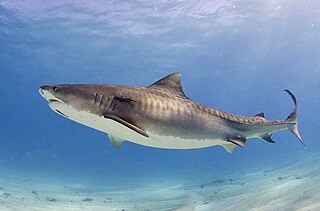
Galeocerdo is a genus of ground shark. Only a single species, G. cuvier, the tiger shark is extant. The earliest fossils date back to the early Eocene epoch, (Ypresian), around 56–47.8 Million years ago. While historically considered a member of the requiem shark family Carcharhinidae, it is currently considered to be the only member of the family Galeocerdonidae. While this genus was historically considered diverse, including 21 extinct species, morphometric analysis conducted in 2021 suggested that the diversity of the genus included only 5 extinct species much lower than previously assumed. The oldest fossils of the extant G. cuvier date to the middle Miocene.

The Mobulidae are a family of rays consisting mostly of large species living in the open ocean rather than on the sea bottom.

Carcharias is a genus of mackerel sharks belonging to the family Odontaspididae. Once bearing many prehistoric species, all have gone extinct with the exception of the critically endangered sand tiger shark.
Coupatezia is a prehistoric genus of ray in the family Dasyatidae whose fossils are found in strata dating from the Maastrichtian stage until the last species' extinction during the Middle Eocene. These rays were found shallow seas in Europe, Africa and the eastern United States.
Jefitchia is an extinct genus of prehistoric drum. Species lived from 48.6–33.9 mya . Jefitchia have been uncovered in Texas, Louisiana, and Portugal.
Chrysocetus is a genus of extinct early whale known from Late Eocene-aged fossils of the eastern United States and western Africa.

Cretalamna is a genus of extinct otodontid shark that lived from the latest Early Cretaceous to Eocene epoch. It is considered by many to be the ancestor of the largest sharks to have ever lived, such as Otodus angustidens, Otodus chubutensis, and Otodus megalodon.
Eocetus is an extinct protocetid early whale known from the early late Eocene Giushi Formation in Gebel Mokattam, outside Cairo, Egypt. The specimen was first named by Fraas as Mesocetus schweinfurthi. However, the name Mesocetus was previously used causing a change to the species name to Eocetus schweinfurthi. Since the genus was first described in the early 20th century, several other specimens, mostly isolated vertebrae, have been attributed to Eocetus, but the taxonomic status of these widely distributed specimens remain disputed.

Parotodus, commonly known as the false-toothed mako shark, is an extinct genus of mackerel shark that lived approximately 53 to one million years ago during the Eocene and Pleistocene epochs. Its teeth, which are found worldwide, are often prized by fossil collectors due to their rarity. The scarcity of fossils is because Parotodus likely primarily inhabited open oceans far away from the continents.

Galeocerdo alabamensis is an extinct relative of the modern tiger shark. Nomenclature of this shark has been debated, and recent literature identified it more closely with the Physogaleus genus of prehistoric shark, rather than Galeocerdo. The classification of Physogaleus is known as tiger-like sharks while Galeocerdo refers to tiger sharks. In 2003, P. alabamensis was classified as Galeocerdo. However, in 2019 they were proclaimed to be more morphologically similar to the genus Physogaleus. This definition was based primarily on tooth shape, as the majority of information on P. alabamensis is a result of studying tooth fossils. Distinctions between Physogaleus and Galeocerdo are difficult with extinct sharks from the Oilgocene/Miocene as there is little paleobiological information allowing for hard conclusions.
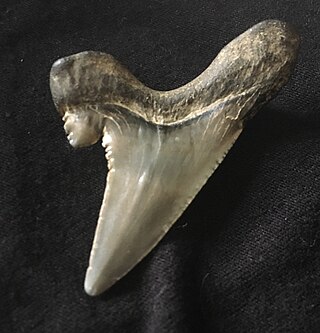
Otodus aksuaticus is an extinct species of large shark in the family Otodontidae which may represent a transitional species between Otodus obliquus and Otodus auriculatus. They are similar in overall morphology to Otodus obliquus except they have serrations on their cusps and blade. It is sometimes placed in the genus Otodus. It is mainly found in the Ypresian stage of the Eocene epoch. They have been found in the Woodstock Member of the Nanjemoy Formation of Maryland and Virginia and Ypresian sediments in Aktulagay, Kazakhstan as well as the Ypres clay in Belgium and the London Clay in the United Kingdom.

Trigonotodus is an extinct genus of sharks, most likely belonging to the family Alopiidae. This genus includes three extinct species, which span from the early Eocene to the late Oligocene. It was originally placed in the family Otodontidae, but subsequently found to have affinities with Thresher sharks. This genus is sometimes considered part of the genus Alopias. It is currently only known from isolated teeth.
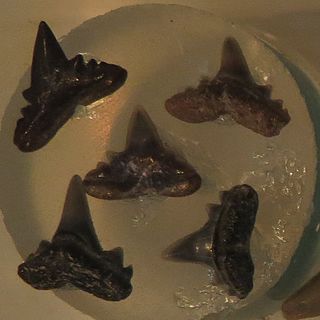
Abdounia is an extinct genus of requiem shark which lived during the Paleogene period. It is mainly known from isolated teeth. It is one of the earliest requiem sharks, and attained widespread success in North America, Europe, and Africa.

Xiphodolamia is a rare extinct genus of mackerel shark which lived during the Eocene epoch. It is only known from isolated teeth, but has been found in Europe, Africa, and Asia. It is assumed to be pelagic, occurring more frequently in deeper water deposits, most notably the London Clay and Eocene deposits in Denmark. It is distinguished by its rectangular root and twisted blade, unique among Mackerel sharks. It is unclear what niche this specialized dentition helped exploit.

Abdounia recticona is an extinct species of requiem shark from the Eocene epoch. It is known from isolated teeth in Europe and North America.
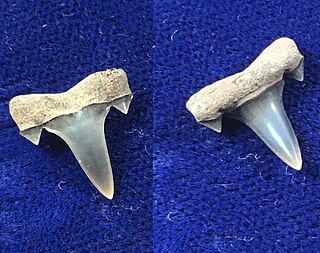
Isurolamna is an extinct genus of mackerel shark from the Paleogene period. It contains at least three species and a fourth is sometimes placed in it. It is thought to be closely related to Macrorhizodus, Isurus, and Cosmopolitodus. Isurolamna arose in the Paleocene epoch during the Selandian age, and was extinct by the close of the Rupelian age of the Oligocene epoch. Some features which define this genus include a small, elliptical foramen (hole) in the middle of the lingual side of the root, triangular cusps except on lower interior teeth, and a relatively thick root with nearly vertical margins. The genus has a complicated taxonomic past.
Aturobatis is an extinct genus of Myliobatiform ray from the Eocene epoch. It contains a single described species, A. aquensis; however, the range of variation in this species is not well understood and it is unclear whether all specimens attributed to the genus are the same species. It is also unknown to which family this genus belongs. The type locality is the Lutetian of southern France. This genus is also known from the Ypresian of the United States, the Lutetian Lisbon Formation of Alabama, and the Priabonian Samlat Formation of Dakhla, Morocco.
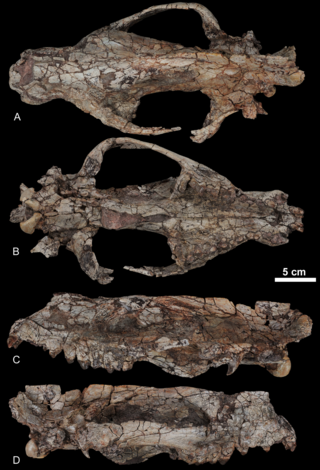
Kerberos ("Cerberus") is an extinct genus of hyainailourid hyaenodonts in polyphyletic tribe Hyainailourini within paraphyletic subfamily Hyainailourinae, that lived in Europe. It contains the single species Kerberos langebadreae.
Tethylamna is an extinct genus of mackerel sharks that lived during the Eocene. It contains one valid species, T. dunni, and another potential species, T. twiggsensis. Its fossils have been found in North America, South America, Africa, and Asia. T. twiggsensis has also been assigned to Brachycarcharias.

Dentaneosuchus is a genus of large bodied sebecid crocodylomorph from the Middle Eocene of Issel and Réalmont (France). Originally described as Atacisaurus crassiproratus, the discovery of additional remains led to it being placed in a separate genus in 2023. It was tentatively recovered as the basalmost member of the family Sebecidae. Because of this Dentaneosuchus could play an important part in deciphering the origins and dispersal of European sebecids, as their presence on the continent, far away from their primary range in South America, is still not entirely resolved. It reached a similar size to the enormous Barinasuchus, making it not only one of the biggest sebecids but also the biggest terrestrial carnivore of Cenozoic Europe. Dentaneosuchus would have been an apex predator of its environment, capable of taking large prey such as Lophiodon. However, for as of yet unknown reasons crocodylomorphs would lose their spot as top predator in this part of the world by the end of the Eocene, with Dentaneosuchus representing one of the last members of its group in Europe.












